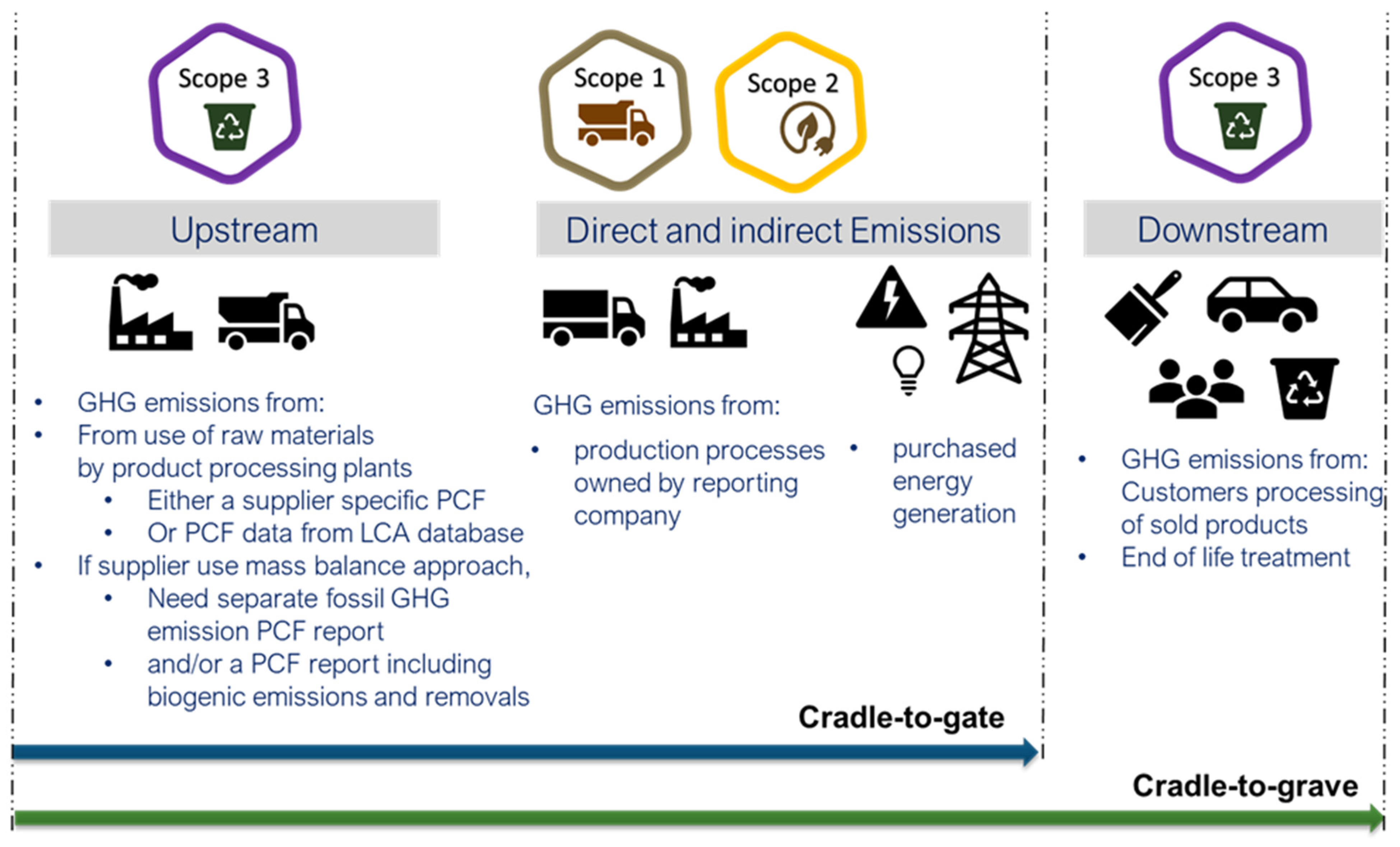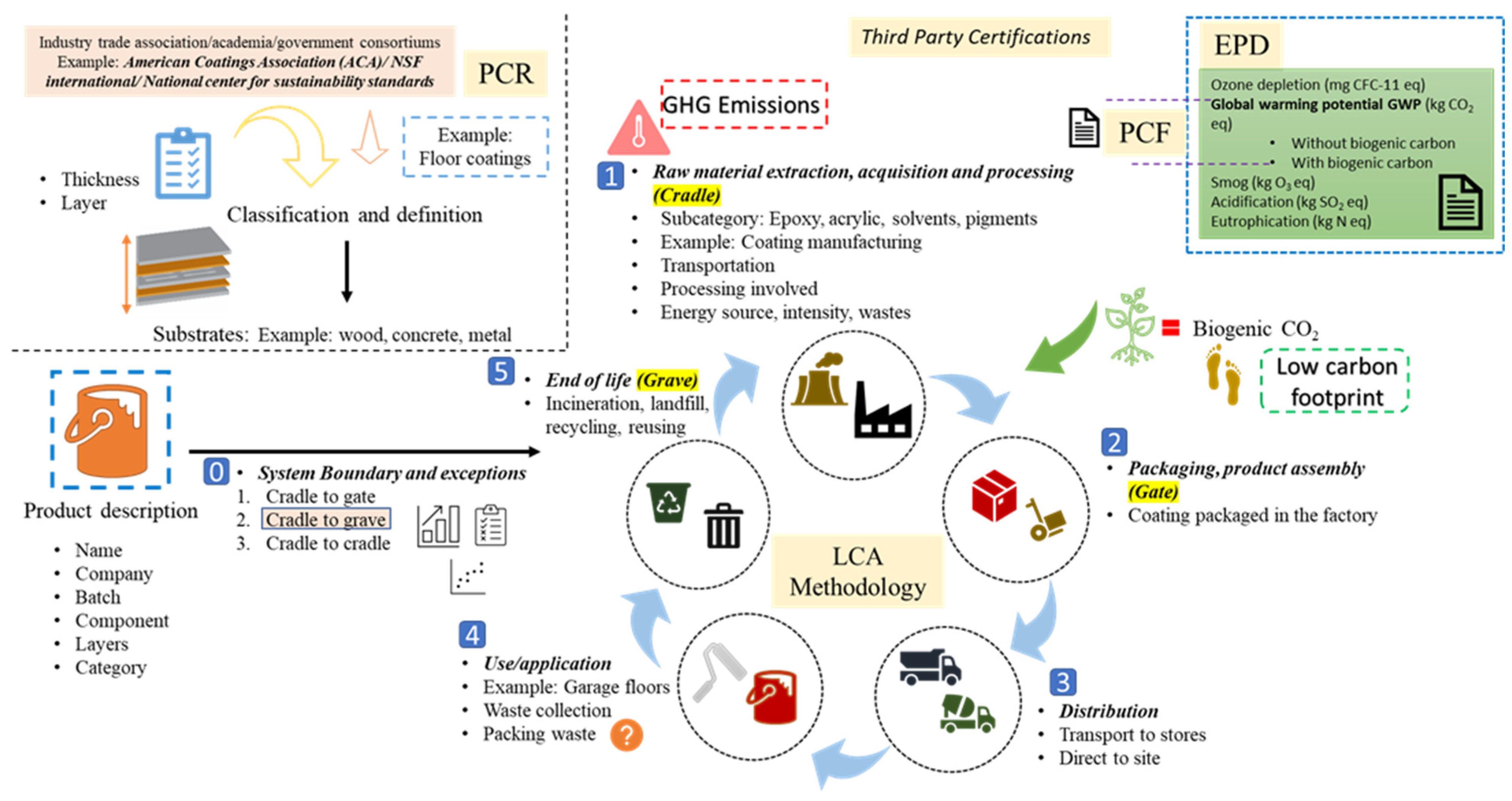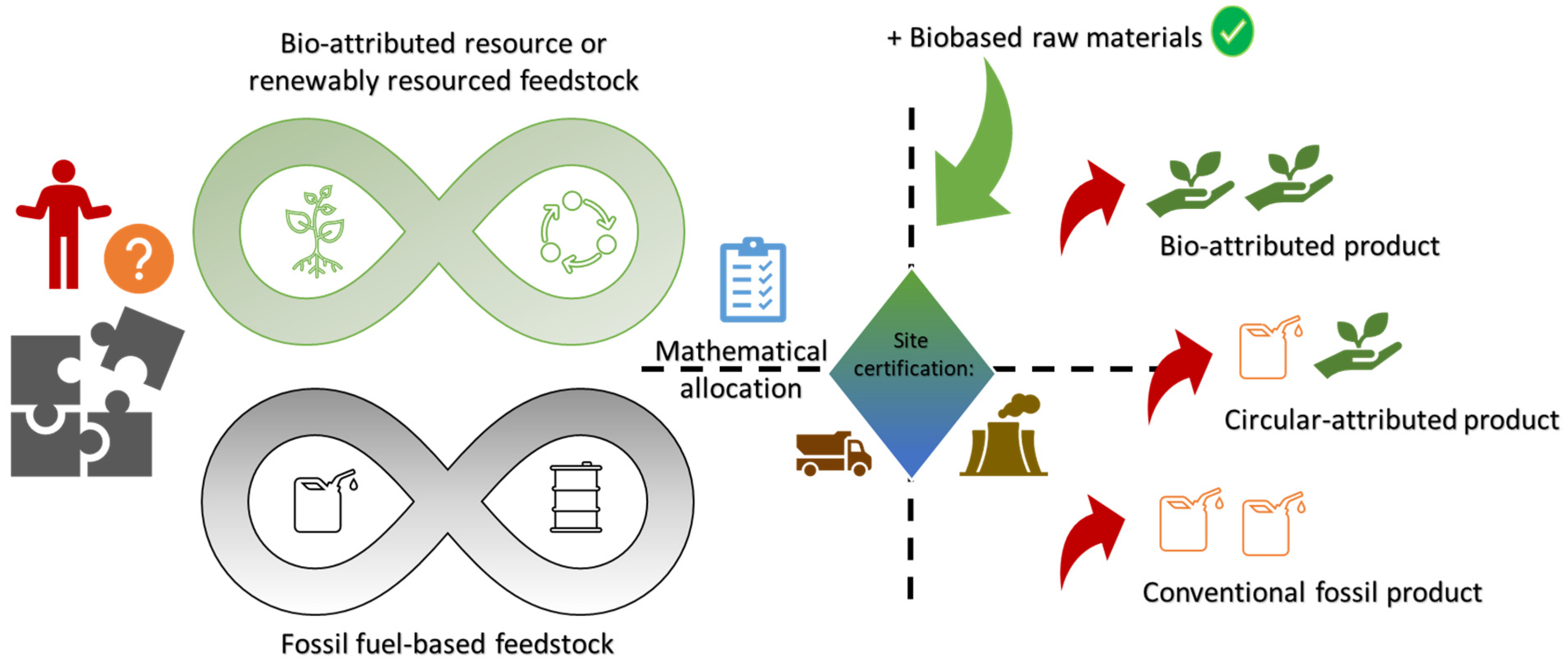Navigating the Labyrinth of Polymer Sustainability in the Context of Carbon Footprint
Abstract
:1. Introduction
2. Holistic Outlook
3. Deep Dive into Biobased/Biomass/Bio-Attributed Approaches
4. Targets, Certifications within the Polymer Industry
5. Discussion and Future Aspect
Author Contributions
Funding
Institutional Review Board Statement
Informed Consent Statement
Data Availability Statement
Conflicts of Interest
References
- Mohanty, A.K.; Misra, M.; Drzal, L.T. Natural Fibers, Biopolymers, and Biocomposites; CRC Press: Boca Raton, FL, USA, 2005. [Google Scholar] [CrossRef]
- Thomas, J.; Patil, R.S.; John, J.; Patil, M. A Comprehensive Outlook of Scope within Exterior Automotive Plastic Substrates and Its Coatings. Coatings 2023, 13, 1569. [Google Scholar] [CrossRef]
- Constantin, C.P.; Aflori, M.; Damian, R.F.; Rusu, R.D. Biocompatibility of polyimides: A mini-review. Materials 2019, 12, 3166. [Google Scholar] [CrossRef] [PubMed]
- Thomas, J.; Bouscher, R.F.; Nwosu, J.; Soucek, M.D. Sustainable Thermosets and Composites Based on the Epoxides of Norbornylized Seed Oils and Biomass Fillers. ACS Sustain. Chem. Eng. 2022, 10, 12342–12354. [Google Scholar] [CrossRef]
- Thomas, J.; Patil, R. Enabling Green Manufacture of Polymer Products via Vegetable Oil Epoxides. Ind. Eng. Chem. Res. 2023, 62, 1725–1735. [Google Scholar] [CrossRef]
- Grishanov, S. Structure and Properties of Textile Materials; Woodhead Publishing Limited: Sawston, UK, 2011. [Google Scholar] [CrossRef]
- Shamsuyeva, M.; Endres, H.J. Plastics in the context of the circular economy and sustainable plastics recycling: Comprehensive review on research development, standardization and market. Compos. Part C Open Access. 2021, 6, 100168. [Google Scholar] [CrossRef]
- Thomas, J.; Patil, R.S.; Patil, M.; John, J. Addressing the Sustainability Conundrums and Challenges within the Polymer Value Chain. Sustainability 2023, 15, 15758. [Google Scholar] [CrossRef]
- Sustainable Business Network. Glossary of Sustainability; Sustainable Business Network: Auckland, New Zealand, 2022; pp. 1–7. Available online: https://sustainable.org.nz/learn/tools-resources/glossary-of-sustainability/ (accessed on 27 May 2024).
- Besley, A.; Vijver, M.G.; Behrens, P.; Bosker, T. A standardized method for sampling and extraction methods for quantifying microplastics in beach sand. Mar. Pollut. Bull. 2017, 114, 77–83. [Google Scholar] [CrossRef]
- Righetti, G.I.C.; Faedi, F.; Famulari, A. Embracing Sustainability: The World of Bio-Based Polymers in a Mini Review. Polymers 2024, 16, 950. [Google Scholar] [CrossRef] [PubMed]
- Fadlallah, S.; Allais, F. Sustainability Appraisal of Polymer Chemistry Using E-Factor: Opportunities, Limitations and Future Directions. ACS Symp. Ser. 2023, 1451, 3–30. [Google Scholar] [CrossRef]
- EPD, Product Category Rule 2020:06. 2020. Available online: https://www.environdec.com/pcr-library (accessed on 27 May 2024).
- NSF International. Product Category Rule for Environmental Product Declarations: Fenestration Assemblies; NSF International: Ann Arbor, MI, USA, 2023. [Google Scholar]
- Subramanian, V.; Ingwersen, W.; Hensler, C.; Collie, H. Product Category Rules. 2012, pp. 1–14. Available online: http://www.springerlink.com/content/qp4g0x8t71432351/ (accessed on 27 May 2024).
- ICCA. How to Know If and When It’s Time to Commission a Life Cycle Assessment; The International Council of Chemical Associations: Brussels, Belgium, 2013; p. 20. Available online: http://lcacenter.org/lcaxiii/final?presentations/782.pdf (accessed on 27 May 2024).
- UNEP/SETAC Life Cycle Initiative, Life Cycle Approaches: The Road from Analysis to Practice, Assessment. 2005, 89. Available online: https://www.lifecycleinitiative.org/wp-content/uploads/2012/12/2005%20-%20LCA.pdf (accessed on 27 May 2024).
- Rangelov, M.; Dylla, H.; Harvey, J.; Meijer, J.; Ram, P. Tech Brief: Environmental Product Declarations—Communicating Environmental Impact for Transportation Products; FHWA: Washington, DC, USA, 2021; p. 14. Available online: https://www.fhwa.dot.gov/pavement/sustainability/hif21025.pdf (accessed on 27 May 2024).
- Footprint, C.; Scope, C.; Accounting, E. The Product Carbon Footprint Guideline for the Chemical Industry Specification for The full PCF Guideline has been launched by TfS. 2024. Available online: https://www.tfs-initiative.com/app/uploads/2024/03/TfS_PCF_guidelines_2024_EN_pages-low.pdf (accessed on 27 May 2024).
- World Resources Institute. World Business Council for Sustainable Development, Product Life Cycle Accounting and Reporting Standard, Septiembre 2011. pp. 1–148. Available online: https://ghgprotocol.org/ghg-protocol-corporate-suite-standards-and-guidance-update-process (accessed on 27 May 2024).
- Gil, S. Edana Environmental Claims Guidelines. 2018. Available online: https://www.edana.org/docs/default-source/sustainability/edana-guidelines-on-environmental-claims-2018.pdf?sfvrsn=62a27e4f_2 (accessed on 27 May 2024).
- Operator, P.; Holder, D.; Number, D.; Product, D.; Category, P.; Operator, P.; Company, T.S.; Gloria, T.P.; Consultants, I.E.; Favilla, T.; et al. Environmental Product Declaration—Product Definition: Duration ® Exterior Acrylic Is a Family of Exterior Architectural Coatings Manufactured by The Sherwin-. 2006. Available online: https://info.nsf.org/Certified/Sustain/ProdCert/EPD10617.pdf (accessed on 27 May 2024).
- Township, C.; Number, D.; Product, D.; Ultralastik, C.; Category, P.; Operator, P.; Contents, P.; Gloria, T.P. Environmental Product Declaration—COMEX® Floor coating system Ultralastik/EFM-104/EFM-105. 2006. Available online: https://info.nsf.org/Certified/Sustain/ProdCert/EPD10148.pdf (accessed on 27 May 2024).
- Clariant, F. Hostavin 3206 liq *0200. 2023. Available online: https://www.clariant.com/en/Solutions/Products/2014/06/17/07/59/Hostavin-3206-liq (accessed on 27 May 2024).
- Office of the under Secretary of Defense for Acquisition and Sustainment. Secretary, Department of Defense Plan to Reduce Greenhouse Gas Emissions. 2023. Available online: https://media.defense.gov/2023/Jun/16/2003243454/-1/-1/1/2023-DOD-PLAN-TO-REDUCE-GREENHOUSE-GAS-EMISSIONS.PDF (accessed on 27 May 2024).
- Heeter, J.; McLaren, J. Innovations in voluntary renewable energy procurement: Methods for expanding access and lowering cost for communities, governments, and businesses. In Voluntary Markets in Renewable Energy: Status, Trends and Options; U.S. Department of Energy, Office of Scientific and Technical Information: Washington, DC, USA, 2013; pp. 31–83. [Google Scholar]
- Chakraborty, I.; Chatterjee, K. Polymers and Composites Derived from Castor Oil as Sustainable Materials and Degradable Biomaterials: Current Status and Emerging Trends. Biomacromolecules 2020, 21, 4639–4662. [Google Scholar] [CrossRef]
- Joseph, T.M.; Unni, A.B.; Joshy, K.S.; Mahapatra, D.K.; Haponiuk, J.; Thomas, S. Emerging Bio-Based Polymers from Lab to Market: Current Strategies, Market Dynamics and Research Trends. C-J. Carbon Res. 2023, 9, 30. [Google Scholar] [CrossRef]
- USEPA. Framework for Assessing Biogenic CO2 Emissions from Stationary Sources; USEPA: Washington, DC, USA, 2014; p. 63. [Google Scholar]
- United States Department of State. The Long-Term Strategy of the United States: Pathways to Net-Zero Greenhouse Gas Emissions by 2050. IEEE 2021, 1–63. Available online: https://www.whitehouse.gov/wp-content/uploads/2021/10/US-Long-Term-Strategy.pdf (accessed on 27 May 2024).
- Thomas, J.; Singh, V.; Jain, R. Synthesis and characterization of solvent free acrylic copolymer for polyurethane coatings. Prog. Org. Coatings 2020, 145, 105677. [Google Scholar] [CrossRef]
- Thomas, J.; Patil, R. The Road to Sustainable Tire Materials: Current State-of-the-Art and Future Prospectives. Environ. Sci. Technol. 2023, 57, 2209–2216. [Google Scholar] [CrossRef] [PubMed]
- Thomas, J.; Nwosu, J.; Soucek, M.D. Acid-Cured Norbornylized Seed Oil Epoxides for Sustainable, Recyclable, and Reprocessable Thermosets and Composite Application. ACS Appl. Polym. Mater. 2023, 5, 2230–2242. [Google Scholar] [CrossRef]
- Patil, R.S.; Thomas, J.; Patil, M.; John, J. To Shed Light on the UV Curable Coating Technology: Current State of the Art and Perspectives. J. Compos. Sci. 2023, 7, 513. [Google Scholar] [CrossRef]
- RameshKumar, S.; Shaiju, P.; O’Connor, K.E.; P, R.B. Bio-based and biodegradable polymers—State-of-the-art, challenges and emerging trends. Curr. Opin. Green Sustain. Chem. 2020, 21, 75–81. [Google Scholar] [CrossRef]
- Ferreira-Filipe, D.A.; Paço, A.; Duarte, A.C.; Rocha-Santos, T.; Silva, A.L.P. Are biobased plastics green alternatives?—A critical review. Int. J. Environ. Res. Public Health 2021, 18, 7729. [Google Scholar] [CrossRef]
- Al-Khairy, D.; Fu, W.; Alzahmi, A.S.; Twizere, J.C.; Amin, S.A.; Salehi-Ashtiani, K.; Mystikou, A. Closing the Gap between Bio-Based and Petroleum-Based Plastic through Bioengineering. Microorganisms 2022, 10, 2320. [Google Scholar] [CrossRef]
- Thomas, J.; Nwosu, J.; Soucek, M.D. Sustainable biobased composites from norbornylized linseed oil and biomass sorghum fillers. Compos. Commun. 2023, 42, 101695. [Google Scholar] [CrossRef]
- Wacker, A.G. The Mass Balance Approach at Wacker. 2023. Available online: www.wacker.com/contact (accessed on 27 May 2024).
- Textile Exchange, Preferred Fibers and Materials Definitions. 2023, pp. 1–14. Available online: https://textileexchange.org/app/uploads/2023/02/Preferred-Fibers-and-Materials-Definitions-Guidance-Jan-2023.pdf (accessed on 27 May 2024).
- Circularity, Production, Mass Balance Approach. 2025. Available online: https://www.basf.com/us/en/who-we-are/sustainability/we-drive-sustainable-solutions/circular-economy/mass-balance-approach.html (accessed on 19 May 2024).
- Solutions, R.; Avenue, T.; Francisco, F.S. Green-e Framework for Renewable Energy Certification. 2017. Available online: https://www.green-e.org/docs/energy/framework/Green-e%20Framework%20for%20Renewable%20Energy%20Certification.pdf (accessed on 27 May 2024).
- ISCC, Iscc Plus, 2023, 3, 1–51. Available online: https://www.iscc-system.org/wp-content/uploads/2023/03/ISCC-PLUS-System-Document_V3.4.pdf (accessed on 19 June 2024).
- Proposal for an EU Definition of Mass Balance. 2023. Available online: https://www.perstorp.com/-/media/files/perstorp/news_files/proposal_for_an_eu_definition_of_mass_balance.pdf (accessed on 27 May 2024).
- Report, One Molecule Can Change Everything. 2021. Available online: https://ungc-production.s3.us-west-2.amazonaws.com/attachments/cop_2022/510552/original/Perstorp_AR2021_framvagn_25mar.pdf?1649349392 (accessed on 27 May 2024).
- Braskem, Introducing Bio-Attributed Mass Balance PP Production, (n.d.). Available online: https://www.braskem.com.br/portal/principal/feirakarquivos/EUROPE/Bio-attributed%20mass%20balance%20PP.pdf (accessed on 27 May 2024).
- Arkema. 3 key points about Mass Balance solutions, (n.d.). Available online: https://www.arkema.com/files/live/sites/shared_arkema/files/downloads/innovation/3-key-points-mass-balance.pdf (accessed on 27 May 2024).
- Jeswani, H.K.; Krüger, C.; Kicherer, A.; Antony, F.; Azapagic, A. A methodology for integrating the biomass balance approach into life cycle assessment with an application in the chemicals sector. Sci. Total Environ. 2019, 687, 380–391. [Google Scholar] [CrossRef] [PubMed]
- Buytaert, V.; Muys, B.; Devriendt, N.; Pelkmans, L.; Kretzschmar, J.G.; Samson, R. Towards integrated sustainability assessment for energetic use of biomass: A state of the art evaluation of assessment tools. Renew. Sustain. Energy Rev. 2011, 15, 3918–3933. [Google Scholar] [CrossRef]
- Majer, S.; Wurster, S.; Moosmann, D.; Ladu, L.; Sumfleth, B.; Thrän, D. Gaps and research demand for sustainability certification and standardisation in a sustainable bio-based economy in the EU. Sustainability 2018, 10, 2455. [Google Scholar] [CrossRef]
- Frequently Asked Questions (FAQ) about the REDcert2 System, 2016, 0–16. Available online: https://www.redcert.org/images/FAQ_REDcert2_March_2016.pdf (accessed on 27 May 2024).
- EPA Report, Learn about Sustainability, What is Sustainability? Why Is Sustainability Important? How Does EPA Promote? 2022; pp. 1–5. Available online: https://www.epa.gov/sustainability/learn-about-sustainability (accessed on 27 May 2024).
- Thomas, J.; Soucek, M.D. Cationic Copolymers of Norbornylized Seed Oils for Fiber-Reinforced Composite Applications. ACS Omega 2022, 7, 33949–33962. [Google Scholar] [CrossRef] [PubMed]
- Pasquero, C.; Poletto, M. Deep Green. In Proceedings of the 40th Annual Conference of the Association of Computer Aided Design in Architecture, Online, 24–30 October 2020; Volume 1, pp. 668–677. [Google Scholar] [CrossRef]
- WWF Indonesia. Sustainable Sourcing Guideline. 2020. Available online: https://www.wwf-scp.org/wp-content/uploads/2021/08/Sustainable-Sourcing-Guideline-ENG-Spread-2.pdf (accessed on 27 May 2024).
- USDE. Sustainable Manufacturing and the Circular Economy, 2023, 1–211. Available online: https://www.energy.gov/sites/default/files/2023-03/Sustainable%20Manufacturing%20and%20Circular%20Economy%20Report_final%203.22.23_0.pdf (accessed on 27 May 2024).
- 2023 Sustainability update/Progress Report. Available online: https://sustainability.wasteconnections.com/static/media/WasteConnections_2023_Sustainability%20Report.9b24b73e78817dd8878d.pdf (accessed on 19 June 2024).
- Council on Environmental Quality. Federal Greenhouse Gas Accounting and Reporting Guidance Council on Environmental Quality. 2016. Available online: https://www.sustainability.gov/pdfs/federal_ghg%20accounting_reporting-guidance.pdf (accessed on 27 May 2024).
- WBCSD; WRI. A Corporate Accounting and Reporting Standard. The Greenhouse Gas Protocol. 2012, 116. Available online: https://ghgprotocol.org/sites/default/files/standards/ghg-protocol-revised.pdf (accessed on 27 May 2024).
- U.S. Environmental Protection Agency Office of Resource Conservation and Recovery. Documentation for Greenhouse Gas Emission and Energy Factors Used in the Waste Reduction Model (WARM). Construction and Demolition Materials Chapters. 2016. Available online: https://www.epa.gov/system/files/documents/2023-12/warm_construction_materials_v16_dec.pdf (accessed on 27 May 2024).
- Carpenter, A.; Reese, S.; Uekert, T.; Wikoff, H.; Peng, P.; Shehabi, A.; IEDO/AMMTO Strategic Analysis Team Led by Joe Cresko. Sustainable and Circular Economy. 2023, 86134. Available online: https://www.nrel.gov/docs/fy23osti/86134.pdf (accessed on 27 May 2024).
- Madaan, S. What is Plastic Pollution? 2018, pp. 1–6. Available online: https://www.eartheclipse.com/environment/environmental-effects-plastic-pollution.html (accessed on 27 May 2024).
- Wilkes, R.A.; Aristilde, L. Degradation and metabolism of synthetic plastics and associated products by Pseudomonas sp.: Capabilities and challenges. J. Appl. Microbiol. 2017, 123, 582–593. [Google Scholar] [CrossRef] [PubMed]
- Johansen, M.B.; Donslund, B.S.; Larsen, E.; Olsen, M.B.; Pedersen, J.A.L.; Boye, M.; Smedsgård, J.K.C.; Heck, R.; Kristensen, S.K.; Skrydstrup, T. Closed-Loop Recycling of Polyols from Thermoset Polyurethanes by tert-Amyl Alcohol-Mediated Depolymerization of Flexible Foams. ACS Sustain. Chem. Eng. 2023, 11, 10737–10745. [Google Scholar] [CrossRef]
- Ramesh, P.; Vinodh, S. State of art review on Life Cycle Assessment of polymers. Int. J. Sustain. Eng. 2020, 13, 411–422. [Google Scholar] [CrossRef]
- Schneiderman, D.K.; Hillmyer, M.A. 50th Anniversary Perspective: There Is a Great Future in Sustainable Polymers. Macromolecules 2017, 50, 3733–3749. [Google Scholar] [CrossRef]
- Papageorgiou, G.Z. Thinking green: Sustainable polymers from renewable resources. Polymers 2018, 10, 952. [Google Scholar] [CrossRef]
- Miller, S.A. Sustainable polymers: Replacing polymers derived from fossil fuels. Polym. Chem. 2014, 5, 3117–3118. [Google Scholar] [CrossRef]





| Abbreviations | Full Form |
|---|---|
| PCR | Product Category Rules |
| PCF | Product Carbon Footprint |
| EPD | Environmental Product Declarations |
| LCA | Life Cycle Assessment/Analysis |
| EOL | End of Life |
| GWP | Global Warming Potential |
| GHG | Greenhouse Gas |
| GaBi | Created by PE INTERNATIONAL, LCA databases containing ready-to use Life Cycle Inventory profiles |
| NCSS | NSF International’s National Center for Sustainability Standards |
| TRACI | Tool for the Reduction and Assessment of Chemical and Other Environmental Impacts |
| ISO Standards | Title/topic |
| ISO 14040 | Environmental management, life cycle assessment, principles and framework |
| ISO 14044 | Environmental management, life cycle assessment, requirements and guidelines |
| ISO 14064 | Greenhouse gases, Part 1: Specification for quantification and reporting of greenhouse gas emissions and removals |
| ISO 14025 | Environmental statement and programs for products, environmental product declarations |
| ISO 14067 | Greenhouse gases, carbon footprint of products, requirements, guidelines for quantification |
| ISO 16620-1 | Plastics: Biobased content, part 1: General principles |
| ISO 16620-2 | Plastics: Biobased content, part 2: Determination of biobased carbon content |
| S.No | Company Name | Certifications | Sustainability Commitments: GHG Emissions Target 2030 | ||
|---|---|---|---|---|---|
| Scope | Reduction % | Baseline Year | |||
| 1 | BASF SE | ISCC+, RedCert2 | 1, 2 | 25 | 2018 |
| 3 | 15 | 2022 | |||
| 2 | Perstorp | ISCC+ | 1, 2 | 46.2 | 2019 |
| 3 | 27.8 | 2019 | |||
| 3 | Arkema | ISCC+ | 1, 2 | 48.5 | 2019 |
| 3 | 54 | 2019 | |||
| 4 | Evonik | ISCC+, TUV | 1, 2 | 25 | 2019 |
| 3 | 11.7 | 2019 | |||
| 5 | Clariant | ISCC+, RedCert2 | 1, 2 | 40 | 2019 |
| 3 | 11.14 | 2019 | |||
| 6 | Dow Chemical | ISCC+ | 1 + 2 + 3 | 15 | 2020 |
| 7 | LyondelBasell | ISCC+ | 1, 2 | 40 | 2020 |
| 3 | 11.14 | 2020 | |||
| 8 | SABIC | ISCC+ | 1 + 2 + 3 | 20 | 2018 |
| 9 | Avient | ISCC+ | 1, 2 | 60 | 2019 |
| 10 | DSM | ISCC+ | 1, 2 | 59 | 2016 |
| 3 | 28 | --- | |||
| 11 | Eastman | ISCC+ | 1, 2 | 33.3 | 2017 |
| 12 | Mitsui Chemicals | ISCC+ | 1, 2 | 40 | 2013 |
| 13 | Dupont | ISCC+ | 1, 2 | 50 | 2019 |
| 3 | 25 | 2020 | |||
| 14 | Solvay | ISCC+ | 1, 2 | 31 | 2018 |
| 3 | 24 | 2018 | |||
| 15 | Braskem | ISCC+ | 1, 2 | 15 | 2019 |
| 16 | Mitsubishi Chemical Corp. | ISCC+ | 1, 2 | 32 | 2019 |
| 17 | LG Chem | ISCC+ | 1, 2 | 27 | 2018 |
| 18 | Covestro | ISCC+ | 1, 2 | 60 | 2020 * |
| 3 | 30 | 2021 * | |||
| 19 | INEOS | ISCC+, RedCert2 | 1 + 2 + 3 | 33 | 2019 |
Disclaimer/Publisher’s Note: The statements, opinions and data contained in all publications are solely those of the individual author(s) and contributor(s) and not of MDPI and/or the editor(s). MDPI and/or the editor(s) disclaim responsibility for any injury to people or property resulting from any ideas, methods, instructions or products referred to in the content. |
© 2024 by the authors. Licensee MDPI, Basel, Switzerland. This article is an open access article distributed under the terms and conditions of the Creative Commons Attribution (CC BY) license (https://creativecommons.org/licenses/by/4.0/).
Share and Cite
Thomas, J.; Patil, R.S.; Patil, M.; John, J. Navigating the Labyrinth of Polymer Sustainability in the Context of Carbon Footprint. Coatings 2024, 14, 774. https://doi.org/10.3390/coatings14060774
Thomas J, Patil RS, Patil M, John J. Navigating the Labyrinth of Polymer Sustainability in the Context of Carbon Footprint. Coatings. 2024; 14(6):774. https://doi.org/10.3390/coatings14060774
Chicago/Turabian StyleThomas, Jomin, Renuka Subhash Patil, Mahesh Patil, and Jacob John. 2024. "Navigating the Labyrinth of Polymer Sustainability in the Context of Carbon Footprint" Coatings 14, no. 6: 774. https://doi.org/10.3390/coatings14060774








